This year is shaping up to be a big one for Apple fans: we’re expecting a plethora of new iOS devices including, most notably, a couple (or even a trio) of brand new iPhone handsets, led by the rumored iPhone 7. Of course, there’ll be a major new iOS update, a second-generation Apple Watch, and new iPads, too, if Cupertino’s usual release cycle is anything to go by.
Because of this, our relationship with the App Store (and its iPhone applications) changes each year, and 2016 is set to be no different. New apps will improve on the functionality of old apps, revamped favorites will replace ageing ones, and our Home screens will evolve and shift to reflect all of the above. So, let’s take a look at the iPhone apps you won’t be able to live without in 2016.
For the photographers
Apple is said to be testing a handful of iPhone 7 prototypes. One of these, according to a recent report (and supported through Apple patent filings), features not one rear-facing camera, but two.

Apple’s patent for its dual camera setup (via Patently Apple)
Because of this, we’re preparing to truly ditch our handheld cameras, video recorders, and D-SLRs for Apple’s iPhone in 2016, making the built-in Camera application (along with third-party photography apps) more essential than ever. Dual cameras would allow for optical zoom (as opposed to the quality-impacting digital zoom few of us dare to use), they would make it possible to shoot video and capture full-resolution images at the same time, or even to shoot regular and slow motion video simultaneously.
For the home
This year is the year Apple’s HomeKit is truly set to take off. With CES 2016 now over, one thing’s for certain: a huge number of HomeKit-compatible products are on their way to the market, making home automation more accessible (and affordable) than ever before. The problem with this is that Apple currently offers no single app solution for controlling all of your HomeKit products inside a single interface. Usefully, a little-known application can help users out.
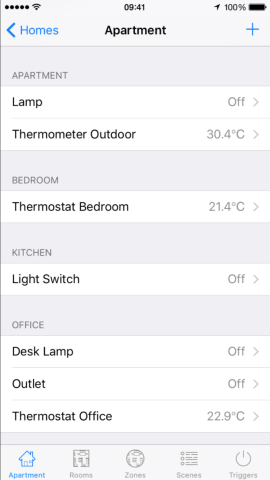
Home for iOS: the HomeKit application that Apple should have developed
Called Home – Smart Home Automation, the app allows iPhone owners to control everything, from their lighting to wall plugs and thermostats, inside of a single interface. It supports time, event, and location triggers; favorites; scenes; and remote access. Plus, an app for the Apple Watch and support for 3D Touch make switching your HomeKit products on and off easier than ever. As more of us purchase devices which are compatible with Apple’s home automation protocol, Home for iOS is going to become even more essential. It’s the HomeKit application Apple should have developed.
For the office
Microsoft Office for iOS continues to surprise us. For folks entrenched in Microsoft’s suite of applications for the office, Microsoft Word (along with Excel and PowerPoint) really are worth checking out. You might have dismissed these apps at first due to their initial launch (originally, the apps required a subscription in order to be used properly). But for some time, it’s been free to edit and create content in Microsoft’s iOS apps; moreover, Office for iPhone now offers the same feature set as its iPad counterparts.
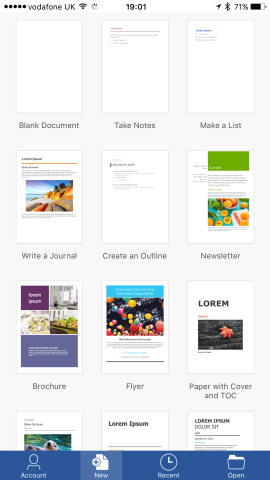
Microsoft Word for iPhone is a great portable document-editing solution that keeps on getting better
No matter whether you’re editing a document on iPhone or iPad, you’ll receive the same features (with a UI that’s instead simply optimized for your particular device). As Microsoft continues to improve the apps through regular updates, Office for iPhone continues to be a trio of applications you won’t be able to live without in 2016.
For the writers
For anyone who attempts to write small or substantial amounts of text on their iPhone, 1Writer is the app we’d now recommend. And because of this, it’s an application you won’t be able to live without in 2016. Office is great for comprehensive documents, but anyone looking for an on-the-go text editor should download 1Writer.
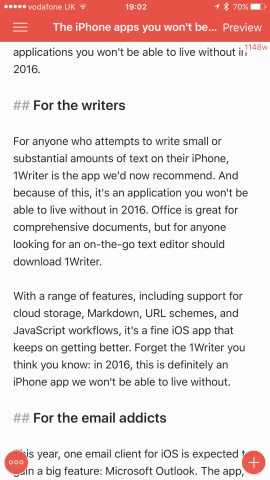
You’ll be amazed at how much you can do in 1Writer (with the right workflows)
With a range of features, including support for cloud storage, Markdown, URL schemes, and JavaScript workflows, it’s a fine iOS app that keeps on getting better. Forget the 1Writer you think you know: in 2016, this is definitely an iPhone app we won’t be able to live without.
For the email addicts
This year, one email client for iOS that’s expected to gain a big feature is Microsoft Outlook. The app, based heavily on Acompli (which Microsoft acquired before releasing the enhanced Outlook for iOS), is a fine email client in its own right. However, Microsoft’s subsequent acquisition of the impressive calendar application Sunrise Calendar spells good news for Outlook users.
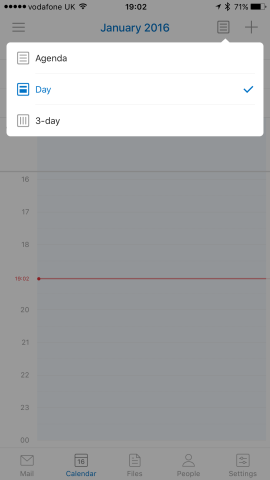
There’s already simple calendar functionality in Outlook for iPhone. But this is about to get even better
You see, in 2016 Microsoft is expected to update its Outlook app, adding improved calendar functionality as a result of its Sunrise acquisition. This move would see Microsoft Outlook for iOS become an all-in-one application for all your email and calendar needs (if you never used Sunrise, it really was a far better solution than Apple’s own Calendar application). As such, while Outlook is an app you should be using, the updated Outlook with Sunrise integration will be an application iPhone owners won’t be able to live without.
For everyone in the Apple ecosystem
There’s an application Apple added to its mobile OS in iOS 9 which, so far, few of us are using: iCloud Drive. This app works with a range of apps for iPhone, iPad, and even Mac in order to sync work between devices. It can also double as a viable alternative to Dropbox or Google Drive.
Using iCloud Drive on the Mac allows users to add files, before accessing them on iOS. You can also use the iCloud Drive iOS app to view files created by other iPhone applications, like Pages or Pixelmator. This year, we’re hoping Apple expands on the functionality of iCloud Drive for iOS in order to make it an essential application. At the minute, adding files into iCloud Drive is tricky on the iPhone, and you can’t save folders for offline access. You can move files between different locations, but the overall experience is pretty inhibiting.
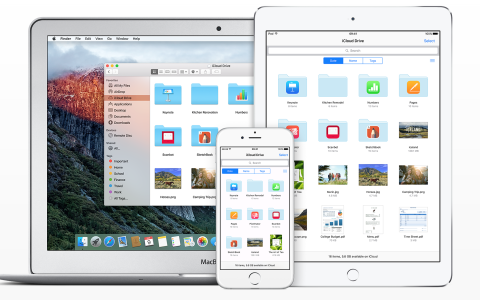
Apple’s iCloud Drive works across all of its iOS devices and Mac computers. But it could be set to get even better in 2016
If you pay a small fee to backup your iPhone to iCloud or to store images in iCloud Photo Library, you’ll have a ton of space in iCloud Drive waiting to be used. In 2016, we hope Apple makes this application more usable (and more user-friendly) in order to position iCloud Drive as a real Dropbox competitor, and to make the application a piece of mobile software we won’t be able to live without.

